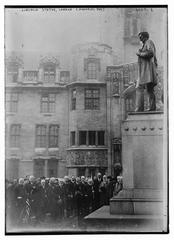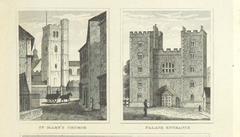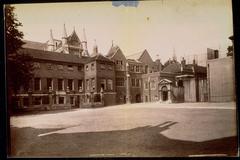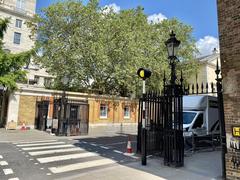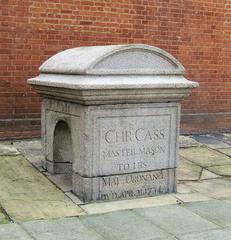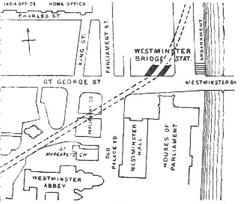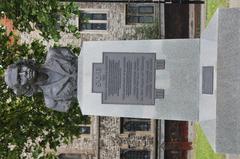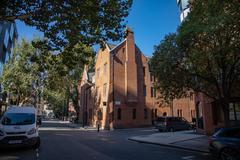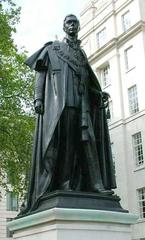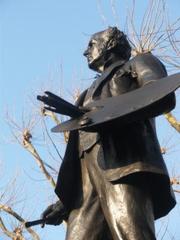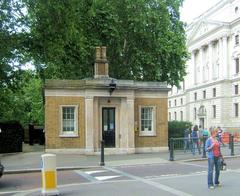Cabmen’s Shelter Kingston Upon Thames: Visiting Hours, Tickets, and Guide to Historical Sites
Date: 14/06/2025
Introduction
Nestled in the heart of Kingston Upon Thames, the Cabmen’s Shelter stands as a rare and evocative relic of Victorian London’s social and transport history. Built originally in 1875 by the Cabmen’s Shelter Fund, these distinctive green huts were designed to provide horse-drawn cab drivers with a safe, accessible place to rest and eat—at a time when leaving their cabs unattended was prohibited by law. Of the 61 shelters once scattered across London, fewer than 15 survive today, and Kingston’s shelter remains a cherished local landmark, symbolizing the evolution of urban life and working-class culture (MyLondon; Historic England).
The shelter’s compact, timber-framed Victorian design—no larger than a horse and cart—reflects the practical constraints of its era and the architectural vision of Maximilian Clarke. Beyond its physical form, the shelter has served as a unique social institution, fostering camaraderie among drivers and promoting sobriety and professionalism since its inception (BBC Travel; Time Out London).
While interior access remains exclusive to licensed cab drivers, the shelter’s legacy endures as a living monument—protected with Grade II listed status, featured in heritage walking tours, and celebrated as part of Kingston’s vibrant community (Kingston Heritage; Candace Abroad). This guide offers a comprehensive overview of the shelter’s historical significance, visiting hours, accessibility, nearby attractions, and tips for respectful engagement—making it invaluable for history enthusiasts, cultural explorers, and curious travelers alike.
Historical Background
The first Cabmen’s Shelters were erected by the Cabmen’s Shelter Fund in 1875 to address the challenges faced by London’s cab drivers, who were forbidden by law from leaving their vehicles unattended. Lacking access to affordable, alcohol-free places to rest, drivers often relied on public houses—raising concerns about sobriety and professionalism (MyLondon). The solution: compact, green-painted huts strategically placed at key locations, including Kingston Upon Thames.
Between 1875 and 1914, 61 shelters were constructed, but only a fraction remain today. The Kingston shelter is a rare survivor, testament to the borough’s commitment to preserving its historical assets and the enduring relevance of these structures (MyLondon).
Architectural Features and Preservation
The Kingston Cabmen’s Shelter retains all the classic hallmarks of its kind: painted in the iconic “cabmen’s green,” with timber framing, a pitched roof, and modest decorative details. Designed for functionality and charm, the shelter includes windows for natural light and a small porch for weather protection.
All surviving cabmen’s shelters—including Kingston’s—enjoy Grade II listed status, ensuring protection from demolition or unsympathetic alterations (Historic England). The listing highlights their role as “distinctive relics of the horse-drawn age in the capital,” and their continued use by taxi drivers in the modern era.
Cultural Significance and Community Role
Far more than a historical curiosity, the Cabmen’s Shelter is a living part of Kingston’s community fabric. For over a century, it has functioned as a social hub for cab drivers, fostering mutual support and camaraderie. Entry is traditionally restricted to licensed drivers who have passed “The Knowledge”—London’s famously rigorous street test (MyLondon). This exclusivity has preserved the shelter’s original atmosphere and social function.
The shelter remains a powerful symbol of the borough’s working-class heritage and urban evolution, providing a tangible link to the days of horse-drawn hansom cabs and the bustling Victorian streetscape.
Visiting the Cabmen’s Shelter: Practical Information
Location and Accessibility
The Kingston Cabmen’s Shelter is centrally located, typically near major taxi ranks or transport hubs. Its green exterior and compact size make it easily recognizable within the urban landscape.
While the shelter itself is not generally open to the public, its exterior can be freely admired and photographed. Its proximity to other attractions—such as the riverside, Kingston Market, and the Rose Theatre—makes it an ideal stop during a walking tour of the town (Candace Abroad).
Visiting Hours and Tickets
- Hours: The shelter operates primarily to serve cab drivers, typically from early morning (around 7 am) until mid-afternoon (2–3 pm). Hours may vary, so checking with local visitor centers or heritage sites is advised (Atlas Obscura).
- Tickets: There is no entry fee or ticket required. Interior access is reserved for licensed cab drivers, but visitors can purchase food and drinks from the exterior serving hatch.
Etiquette and Photography
Visitors are welcome to photograph the shelter’s exterior, but should not attempt to enter or disturb those using the facility. Engaging with local drivers at the hatch can offer insights, provided it’s done respectfully. Always queue politely and observe the shelter’s longstanding rules (no gambling, drinking, swearing, or political debate).
Food and Drink Experience
A highlight of the Cabmen’s Shelter is its traditional British fare—bacon rolls, sandwiches, and hearty breakfasts, all at affordable prices (Restaurant Guru). Coffee and tea are staples, and the service is known for being warm and efficient. While interior seating is reserved for drivers, visitors can enjoy takeaway meals, making it a favorite among locals and tourists seeking an authentic, budget-friendly bite (MyLondon; Atlas Obscura).
Atmosphere and Ambience
The shelter’s flower boxes, iron bell, and riverside backdrop create a scene that is both timeless and quintessentially British. The order window is a meeting point for local cabbies, staff, and curious visitors, all set against the hum of Kingston’s market square and the gentle sounds of the Thames (Unusual Places).
Accessibility and Practical Tips
- Opening Hours: Visit during breakfast or lunch to enjoy the full menu and avoid crowds (Atlas Obscura).
- Payment: Cash is preferred, though some shelters may accept contactless payments.
- Getting There: Located near Kingston Market Place and riverside walkways, and a short walk from Kingston railway station (A Lady in London).
- Accessibility: The serving hatch is at street level, but interior access is limited to drivers.
Nearby Attractions
Kingston Upon Thames is rich in history and culture. After visiting the shelter, explore:
- Kingston Market Place: A bustling square with local produce and independent traders (Candace Abroad).
- Rose Theatre: The largest producing theatre in South West London.
- Kingston Museum: Exhibits on local history and innovation (Kingston Heritage).
- Riverside Walks: Scenic paths with views of the Thames.
- Coronation Stone: Site of ancient royal coronations.
- All Saints Church: Notable for its stained glass and historic architecture.
Special Events and Tours
Kingston’s 2025 Cultural Celebration will feature public art, river festivals, and historical reenactments, often including the Cabmen’s Shelter in local history trails (Kingston Heritage; Kingston 2025). Guided walking tours are occasionally available—check with local tourism resources for schedules.
Photographic Opportunities
The shelter’s green exterior, period details, and riverside setting make it a favorite for photographers. Early morning or late afternoon light is ideal, and candid shots of cabbies and customers add authentic local flavor.
Etiquette and Conduct
- Queue respectfully at the order window.
- Do not attempt to enter the interior unless invited.
- Maintain a polite, low-key demeanor—these spaces are primarily for working drivers.
FAQ
Do I need a ticket to visit the Cabmen’s Shelter?
No, entry is free. Food and drinks can be ordered from the exterior window.
What are the opening hours?
Typically from 7 am to mid-afternoon, but check locally for specific times.
Is the shelter wheelchair accessible?
The order window is at street level; interior access is reserved for drivers.
Can I eat inside the shelter?
Only licensed taxi drivers may use interior seating; visitors should plan for takeaway.
Are guided tours available?
Occasionally, especially during cultural events—check with local tourism organizations.
Summary and Further Exploration
The Cabmen’s Shelter in Kingston Upon Thames is more than a quaint Victorian hut—it’s a living emblem of London’s enduring social history, philanthropy, and working-class identity. Its continued use, Grade II protection, and vibrant community role make it a must-see for visitors interested in Kingston’s layered past and present (Historic England; BBC Travel).
Combine your visit with other local attractions, enjoy traditional fare, and respect the shelter’s primary role as a working facility. For more on Kingston’s history and events, consult heritage organizations, tourism websites, and local visitor centers.
Download the Audiala app for curated tours and interactive maps, and follow us on social media for the latest updates and insider tips. Begin your exploration of Kingston and uncover the stories woven into its historic streets.
Sources
- History of London’s Cabmen’s Shelters, 2023, MyLondon
- Historic England - Cabmen’s Shelters Listing, 2025
- The Secret Green Shelters That Feed London’s Cabbies, 2018, BBC Travel
- Everything You Need to Know About Cabmen’s Shelters, 2016, Time Out London
- Things To Do in Kingston Upon Thames, 2024, Candace Abroad
- Kingston Heritage and 2025 Cultural Celebration, Kingston 2025
- Cabmen’s Shelter in Russell Square, 2024, Atlas Obscura
- Restaurant Guru - Embankment Cabmen’s Shelter
- A Lady in London - Day Out in Kingston Upon Thames
- Unusual Places - Cabmen’s Shelters: Living History of London
